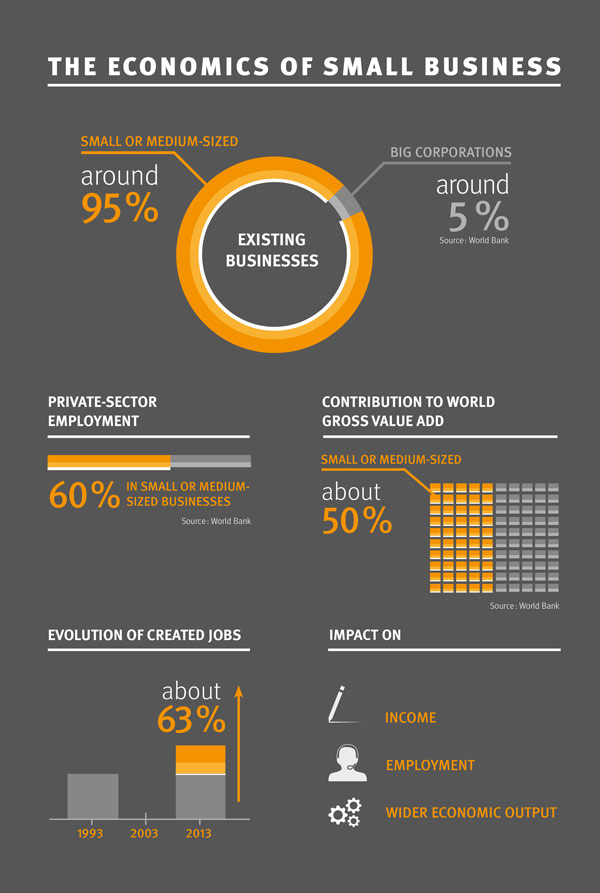Small business is – quite frankly – big business. It is estimated that more than 90 % of the world’s businesses are small and medium-sized enterprises (SMEs). Surprised? Don’t be. SMEs are, on average, the businesses that are generating growth, creating jobs, growing faster and innovating more. But most of all, they are a good deal less complicated (structurally) and more efficient and flexible than are large firms.
It’s not all a bed of roses though. While SMEs make a huge impact on income, employment and wider economic output, their fortunes have been disproportionately affected by the financial crisis. SMEs are both an engine of job creation and a significant factor in job destruction, making them the embodiment of Schumpeter’s “creative destruction”, i.e. the disruptive process of transformation that goes hand in hand with innovation. Confirming these observations, an EU estimate alluded to the shocking fact that as few as 50 % of firms that started trading in 2001 survived beyond five years.
The question of how to serve SMEs is not new. Many researchers, academics and economists have searched for a winning formula over the years, with mixed results. So the question remains: what can be done to bolster SMEs? There is no magic formula for ensuring there is a thriving global SME community – if so it would have probably been implemented long ago – but the expanded use of International Standards can foster entrepreneurship and help small businesses compete on an equal footing.
Why small businesses matter

There is no global agreement on the definition of SMEs, but one thing virtually every country does agree on is that they are essential for economic prosperity. Small companies make up the vast majority of businesses in most countries and employ a significant percentage of the global workforce. Although precise data is unavailable, World Bank research across the world’s economies has estimated that SMEs consistently form around 95 % of existing businesses and employ approximately 60 % of private-sector workers. They are also believed to contribute about 50 % to world gross value add (GVA).
In the USA, for example, the Small Business Administration identified more than 28.2 million businesses operating in the country as of March 2014, with about 63 % of new jobs being created from small business between 1993 and mid-2013. Of these 28.2 million enterprises, most have “self-employed” status, making up roughly three-quarters of the US’s total business pool.
Path out of poverty

According to the United Nations Industrial Development Organization, which sees to the economic welfare of developing countries, integration into the global economy through economic liberalization, deregulation and democratization is seen as the paramount way to triumph over poverty and inequality. Important to this process is the development of an animated private sector in which SMEs can play a central role.
Export specialist Khemraj Ramful, Senior Adviser, Export Quality Management, International Trade Centre, explains how SMEs are essential in poverty reduction programmes because of their potential contribution to economic growth. By facilitating their access to information on technical regulations and standards, assisting them with meeting the requirements of International Standards and paving the way to competent conformity assessment services, we can help these small-scale firms to thrive in an increasingly competitive global market, so that they can play their part in alleviating poverty.
Ramful firmly believes that standards are the solution. “ISO International Standards have a definite role to play in the removal of technical barriers to trade and in assisting enterprises in developing economies that are connected to global value chains. Implementing International Standards can help provide that confidence.” But most importantly, he asserts, “For the man on the street, this means that International Standards like the ISO standards can contribute to improving exports, which would have an impact on job creation and poverty alleviation in developing economies.”
As good as it gets
There’s both good news, and bad news. The good news is that International Standards provide as many benefits for small businesses as they do for global enterprises. The strategic use of International Standards can make a significant difference to the annual turnover of an SME, sometimes the difference between success and failure.
For smaller firms, some of the benefits of using International Standards include:
- The opening up of export markets as products become compatible on a global scale
- Heightened operational efficiency
- Increased confidence as customers from all over the world recognize ISO International Standards
Be that as it may, for many small businesses, making the decision to participate in a standards development process remains difficult, as managers are typically reluctant to allocate resources to a long-term process that promises, at best, intangible benefits. However, if the company is committed and participates actively in the process, the return on investment can be substantial.
The principal benefits of participation include visibility, in-depth understanding, innovation, competitive advantage, networking possibilities, and opportunities to access potential customers. In other words, non-participation in standardization hands decision making over to the competition.
Small business is big business.
So what’s the bad news? A number of recent surveys have linked the low representation of SMEs in standardization to such obstacles as time, personnel or financial resources. According to the 2014 German Standardization Panel, a report on how companies conduct their standardization activities and implement standards, small firms are hampered by financial constraints that prevent many of them from taking an active part in standards development.
According to Knut Blind, Europe’s most prominent academician working in the field of standardization, “formal” standards, such as ISO standards, are used in almost equal measure by all of the thousand or so companies involved in this annual survey, regardless of size. There is one exception, however: while the larger companies of this world have the resources to develop and implement complementary company internal standards, smaller companies with fewer resources rely more heavily on the availability of formal International Standards.
For Blind, it is still a challenge to convince small companies to participate in standardization and send people to the committees. “Most SMEs, particularly the smaller ones, lack the necessary resources to commit to long-term strategies and investments, which are only paying back in the future. Their management is largely involved in daily operational practice, and there is no time or money available for activities not directly related to the daily business. They are forced, therefore, to have a short-term view of their business and are limited in reacting to anticipated changes such as future regulations or the development of new standards.”
Not all benefits are equal
Where Blind sees fundamental challenges for small companies, which must be addressed by awareness-raising activities, a number of small businesses are already reaping the profits of standards use. In a recent interview, Isabelle Jacobi Pilowsky of Rentes Genevoises, the oldest contingency-fund company in Switzerland, extolled the virtues of standards. The small company has long been committed to managing its real estate portfolio responsibly using ISO standards, in particular ISO 50001 to control the energy expenditure of its buildings.

The first results are very positive, enthuses Jacobi Pilowsky. “Our target was to cut our CO2 emissions by 3 % and in 2012, we achieved a 4.7 % reduction.” An excellent initiative for the 30-person company. ISO 50001 allows the institution to set itself targets – and keep to them – such as improving the energy efficiency of their 60-strong building stock and reducing the cost of energy consumption while improving comfort for its tenants.
When asked about advice for other SMEs, Jacobi Pilowsky clasps her hands and exhales. “There’s plenty!” she says, listing a score of useful tips which include the need for measurement tools and scorecards to track performance, the constant monitoring of objectives, and training of all stakeholders. For more tips, see “Secrets to energy success” below.
While Rentes Genevoises succeeded on its own terms, the role of trade associations in improving the situation for SMEs should not be forgotten. Quite simply, trade associations are “strength in numbers”. A top priority would be therefore to establish or improve relationships with these industry groups, discuss their respective roles, and provide them with knowledge and materials.
In Brazil, the non-profit Sebrae helps small businesses compete on an equal footing and get a toehold in the market. It aims to strengthen the national economy, where smaller companies make up an astounding 99 % of all Brazilian enterprises and contribute to 25 % of the country’s GDP. The organization provides support on many levels, such as information technology and finances as well as on ways to access innovation and technology through standards.
Take, for example, the beauty parlours business. There are about 500 000 legally formalized beauty parlours in Brazil, which, until recently, were operating without parameters or formal standards. This is why, a few years ago, Sebrae (in collaboration with ISO’s Brazilian member ABNT) set up a project to help the beauty sector with their standardization needs. In 2014, the first national standard for the beauty sector – was published by ABNT. To help the sector’s SMEs get to grips with standards, two supporting documents are also being made available: Good practices for beauty establishments and Competencies of people working in beauty stores.
“The wave of professionalization initiated by the standardization process was divided into two law bills which regulate the beauty services business in the country (law bills are still in the National Congress),” explains Heloisa Menezes, Sebrae’s Technical Director. “Sebrae, as the coordinator of the process, now has the challenge of disseminating these new technical standards in Brazil, to promote competitiveness and complement systemic improvements already underway with entrepreneurs.”
Doomed to fail?
Are all small businesses doomed to fail? The answer is of course “no”. Interestingly enough, a small number of high-growth businesses do go on to reach a significant size and employ many workers. Furthermore, within the cycle of business births and deaths, SMEs expose incumbents to competition and innovation that force them to change and become more productive. That innovative stimulus helps economies grow.
SMEs are responsible for introducing most of today’s products and services on the markets and are typically much better at identifying and adopting new trends than larger, established corporations. They promote diversification of economic activities, support sustainable development, stimulate innovation, develop entrepreneurial skills, not to mention the significant contribution they make to exports and trade. More importantly, they are structurally a good deal less complicated and more efficient and flexible than larger firms.
With small businesses accounting for approximately half of a country’s business and workforce, we need standard solutions that help small businesses leverage their competitive advantage more effectively. While standards will not shelter small companies from failure, nor will they increase their survival rate, they will level the playing field, allowing them to compete on fair and equal terms. And when they do, we can look forward to a new economic map emerging, where smaller businesses play a big role in shaping the world – at last.
Secrets to energy success
Are you an SME wanting to implement ISO 50001?
Do you need help in doing so? Have no fear!
We asked Isabelle Jacobi Pilowsky of Rentes Genevoises to share with us her top six tips:
- Implement measurement tools for energy performance indicators as well as scorecards that are representative of the objectives set.
- Clarify all processes related to the management of energy resources.
- Base relationships with partners and suppliers on contracts stipulating the services to be provided and the objectives to be achieved in terms of economies of scale.
- Train and/or raise awareness of all stakeholders.
- Formalize and monitor the annual planning of your energy management system.
- Ensure continual improvements are built into the system.
This should help even the smallest company face the future in confidence.


